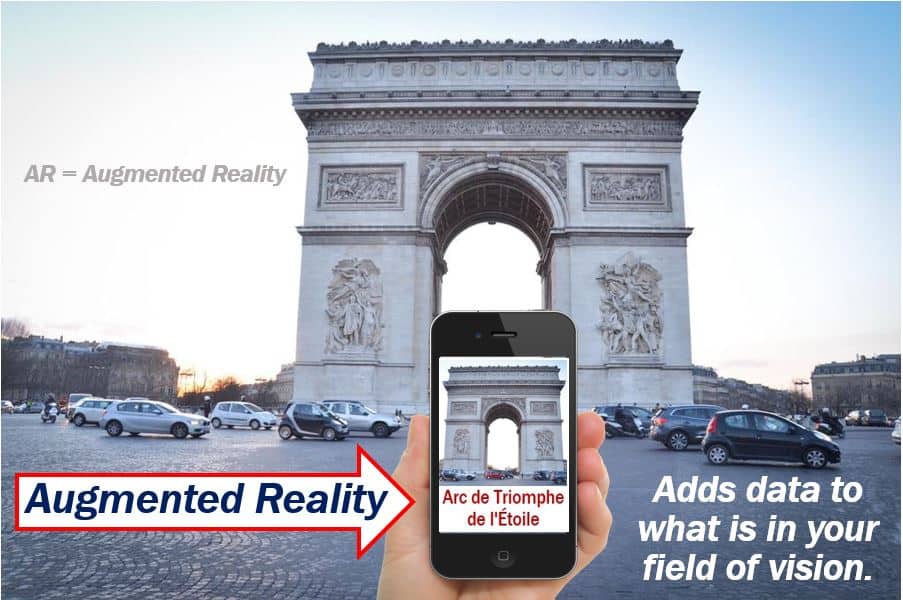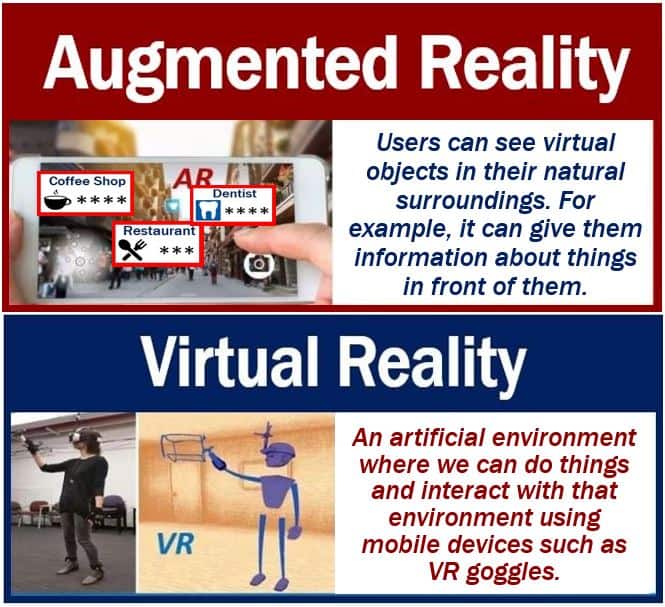Augmented Reality or AR is a technology that presents us with virtual objects and information in our field of vision. If I am looking at a street, for example, and point my smartphone towards that street, it may give me more information, such as names of cafes, gyms, dentists, etc.
Augmented reality gives you data on the things that you can see. It enhances the screen by adding elements to the real world.
AR is great if you want to familiarize yourself with a new part of town or somewhere in a town you’ve never been to before.
Augmented reality vs. virtual reality
Virtual reality or VR is not the same as augmented reality or AR – it is quite different.
Virtual Reality:
VR technology creates a virtual environment. The user wears a helmet or goggles and interacts in the pretend environment, simulation, or virtual reality. In some cases, the user may wear special gloves with sensors, or even a suit.
Virtual reality is a computer-generated simulation of an environment or three-dimensional image where people can interact in a physical or seemingly real way.
With virtual reality, you feel like you are somewhere else. But that other place is a pretend place – a simulation or virtual world. Most people refer to this other place as the ‘environment.’
Augmented Reality:
Augmented reality technology presents users with virtual objects in their natural environment. Users, who are either wearing VR goggles or looking at a smartphone/tablet screen, see information about the things they are looking at.

Augmented reality – an example
Let’s suppose you are walking in the streets of Paris and you see an interesting piece of architecture. It is a large structure that looks like an arch. There are many cars in the area.
You want to know what this amazing building is, its architect, its history, etc.
Your smartphone has an AR app of Paris. You hold up your phone and point it at the structure. Your device uses satellite navigation or GPS to work out where you are.
On your screen, you see the structure plus lots of little icons with text. One says ‘Arc de Triomphe de l’Étoile.’ That is the name of the structure, and your screen tells you it means ‘Triumphal Arch of the Star.’
You also learn from data on your smartphone screen that the monument honors those who fought and died for France in the French Revolutionary and Napoleonic Wars.
Your augmented reality app gives you information about the things in your field of vision, which in this case is the Arc de Triomphe de l’Étoile.

Augmented reality in manufacturing
Imagine a team of workers in a car factory. They have special goggles on which allow them to see what’s in front of them and also give them information that helps them in their work.
A worker, for example, looks at a half made car and sees on the screen the words ‘wait for supervisor.’ The worker knows he or she must wait.
The supervisor also wears special goggles and sees the words ‘Check item 24331 in Bay 3.’ The supervisor immediately goes to Bay 3 and sees the worker waiting. Then the text on the screen says ‘Give trainee John Smith second training session on assembling car doors.’
Augmented reality will one day help coordinate what everybody does in manufacturing plants, computer scientists believe. It could help in hundreds of different ways. This was just one simple example of how manufacturing practices might change in future thanks to augmented reality.
Augmented reality in healthcare
AR is already helping some healthcare professionals operate faster and more effectively.
Surgeons, for example, can put on goggles that project a CAT image or X-ray over a patient’s body to see inside. This gives them much more precision when they are performing surgery.
During an operation, the surgeon can also pull a patient’s medical records in real time without having to stop what they are doing.
In the future, one can imagine surgeons calling on other experts for their opinions on how to proceed right in the middle of surgery. The other surgeon will put on their goggles and be able to see what the surgeon who is operating sees.
AR and VR will drastically change 7 sectors of the economy
Computer scientists at TUM believe that seven sectors of the economy will face drastic disruption in the future because of virtual and augmented reality. The seven sectors are, retail, music, automotive workshops, manufacturing, communications, IT services, and education. TUM stands for Technische Universität München (Technical University of Munich).
Video explanation
